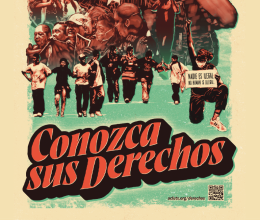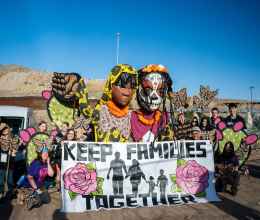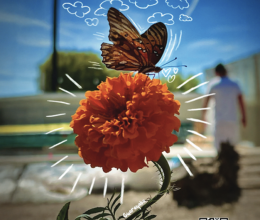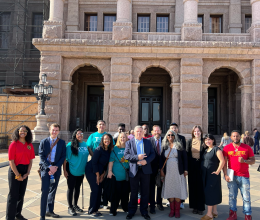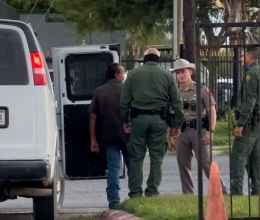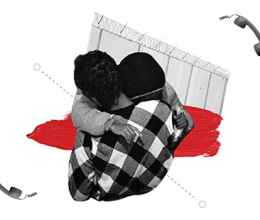
They used the bathroom at a ball game and got arrested. The community asked why. Turns out they’d been spied on by a government camera. But the Border Patrol told a different story.
Late last November on a Sunday morning, twelve days after the Presidential election of Donald Trump, the little South Texas town of La Joya, pop. 3985, was inaugurating its brand new outdoor-sports complex. Fito Salinas, an elderly man with a big smile and neat moustache, had brought a barbecue pit to celebrate. As he grilled tacos, men from a local baseball league played on the nearby diamond.
There was one oversight—the park’s bathrooms weren’t open. That didn’t faze Sandra Rodriguez, a young woman sitting in the bleachers with her six-year-old son, Jiovanni, and some other young children. She grabbed her purse and a bag of toilet tissue, and took the kids just beyond the fence, to pee in nearby brush.
Sandra had no idea that her short walk to the bushes would result in a personal and community fiasco. It’s one that may have foreshadowed the harsh immigration enforcements—including misinformation, disinformation, and outright falsehoods—that have emerged nationwide since Trump took office.
But Trump’s inauguration was in January. That was a full two months after the US Border Patrol and the Texas Department of Safety misrepresented what they did to Sandra Rodriguez in La Joya.
It all started because Sandra’s husband, who makes a living selling hot dogs and hamburgers, also plays catcher for a La Joya baseball team. He and Sandra live in a nearby Texas town, and on November 20 she was rooting for her man with Jiovanni in tow, and with an adult relative and her own young children. That’s when the kids got the call of nature and Sandra took them to relieve themselves.
They walked just outside the sports park, to a sliver of land with trees. It’s part of a large swathe immediately west of the park that’s owned by the US Department of the Interior’s Fish and Wildlife Service (FWS).
Mayor Salinas saw her walk to the land with the children, then return to the bleachers. He thought nothing of it.
Then some troopers from the Texas Department of Public Safety (DPS) drove up. After that, according to witnesses, men in plainclothes arrived, entered the park and started peering at people. They were from the US Border Patrol. They approached the bleachers and began questioning people, including Sandra. They determined that she and Jiovanni were undocumented. Soon the two were being led out of the park and into immigration detention.
Among dozens of stunned onlookers was Frances Salinas De Leon, the mayor’s daughter. She was furious about the agents’ actions, and she had a video camera. In the next few days, her fourteen-minute recording of the incident went viral in the media and on YouTube.
The community had a hard time figuring out why Sandra Rodriguez had been questioned about her immigration status. According to official Border Patrol policy, several kinds of sites, including churches, schools, and community centers, are designated as “sensitive locations,” generally off limits to immigration enforcement. La Joya’s sports park fits the list, Rio Grande Valley Sector Chief Manuel “Manny” Padilla acknowledged last year. As news of the incident spread, indignation grew.
On November 22, two days after the incident, the sector issued a statement. It said agents questioned Rodriguez because they saw a woman and children walking from brush land that was –as the statement put it—“next to” the Rio Grande River.
The Rio Grande River divides Texas and Mexico. It lies about a mile and a half south of the sports park. That distance might sound very short to people in the US interior. But up and down the border in Texas, hundreds of thousands of people lead completely ordinary lives within just a mile and a half of Mexico: residing, working, studying, shopping and playing there.
Nonetheless, the picture painted by the Border Patrol’s statement was of Sandra down at the river by the water. The statement did acknowledge her claim that she was only going to the bathroom. But it implied that the Border Patrol had reason to suspect that she had illegally crossed the international border on the day the park opened, then attempted to hide among the celebrants.
Photographs acquired by the ACLU of Texas through an open-records request show that Sandra Rodriguez and the kids were exactly where she said they were: right by the baseball park. Yet, according to Mayor Salinas, during a private meeting that Rio Grande Valley Border Patrol Sector Chief Manuel “Manny” Padilla had with the mayor on November 28, the chief continued to claim that the group were in a suspect place. He wasn’t saying anymore that Sandra was “next to the river.” Instead, according to Mayor Salinas, Padilla had a new story: that Rodriguez was spotted crossing railroad tracks that lie much closer to the park than the Rio Grande does, but still far enough away to arouse Border Patrol suspicion.
To bolster his revised claim, Salinas said, Padilla displayed an image of Rodriguez and the children. “He told me it showed them crossing the railroad tracks from south to north,” Salinas said. Examining the image, however, Salinas recognized the surroundings as north of the railroad tracks, on FWS land immediately adjacent to the ballpark.
The ACLU of Texas asked FWS about a Border Patrol camera on the land where Rodriguez took the children to the bathroom. Beth Ullenberg, a spokesperson in the national office in Albuquerque, corroborated that last year the Service issued a permit for such a camera to the Border Patrol.
Via numerous emails and phone messages, the ACLU of Texas asked Chief Padilla and the Border Patrol’s Rio Grande Valley Sector press office about the camera, and why they were maintaining it right by a community ballpark. No response was received.
The video made by Salinas DeLeon, the mayor’s daughter, suggests that the Border Patrol immediately recognized that the camera was a problem. On the video, Clarence Catchings, one of the Border Patrol agents who had just apprehended Sandra and her son, is heard talking in Spanish. The video’s volume is low, but listening with headphones makes Catchings’ words clear.
“If there are other people here who are undocumented,” Catchings tells bystanders, “they need to stay out of there.” While saying this, he gestures at nearby land.
Nancy Villarreal, a niece of Sandra, has Catchings’ business card. She says he gave it to her while apologizing for apprehending Sandra, calling the action a mistake. What Catchings did not apologize for is the fact that, with a camera hidden right at the edge of the La Joya ball park, many other community members besides Sandra Rodriguez are at high risk of wandering into a surveillance zone and triggering more “mistakes.”
Even so, the Border Patrol has never publicly acknowledged the camera’s existence.
Neither did the Department of Public Safety (DPS) until the ACLU of Texas requested documents describing the DPS’ role in Sandra Rodriguez’ detention. In response we received emails written hours after the incident, by three DPS agents to their superiors. The emails describe how the agents responded to camera images taken of Rodriguez and the children, then went to the park to investigate. We then asked for the images. Once we had them we compared details in the images with our own inspection of the area immediately by the ballpark. The details match.
It turns out that the camera that took the pictures wasn’t operated solely by the Border Patrol. The DPS had a hand in it, too.
DPS traditionally has sent state troopers onto Texas highways to enforce traffic laws. But during the past few years, it has flooded the border not only with agents but with a surveillance project called Operation Drawbridge. It employs cheap wildlife cameras, the kind that naturalists and hunters use to record passing deer and feral pigs. The cameras can be camouflaged. When activated by the body heat of passing animals or humans, the cameras snap one image every 60 seconds. The images are sent to DPS analysts in Austin, then back to local DPS agents for on-the-ground investigation—as well as to Border Patrol agents.
The Drawbridge camera triggered the La Joya incident appears to be the same one permitted to the Border Patrol by FWS. The FWS’s Beth Ullenberger speculated that the two agencies are sharing. “DPS and Border Patrol work together and at this point are pretty much interchangeable,” she said. (FWS also has agreed to install and maintain Drawbridge cameras for DPS. They’ve done so, for example, at the Santa Ana Wildlife Refuge, about 15 miles east of La Joya, according to a DPS-FWS agreement provided to ACLU of Texas following an open-records request.)
The DPS was asked if the agency is sharing a camera with the Border Patrol in La Joya. Agency press officer Tom Vinger responded that “For officer safety and for operational security (that is, to avoid revealing the camera locations to drug and human smugglers), we do not discuss camera locations.” He added that the DPS flagged the La Joya image as suspicious, but left investigation to the Border Patrol. The placement of a DPS camera in areas where people are engaged in lawful activities, Vinger wrote, is appropriate because “drug and human smuggling can occur in virtually any location.”
The El Paso Times reported in early 2016 that Operation Drawbridge was “in the midst of a massive augmentation.” According to a DPS report from that time, over 1300 cameras had already been placed in the Rio Grande Valley. By the end of that year, according to a recent DPS report, there were 4103 cameras up and down the Texas border with Mexico. Three hundred were added last November. That’s the month when a Drawbridge/Border Patrol camera picked up images of Sandra Rodriguez and the children. Both the humans and the device were right over a fence from the La Joya ballpark.
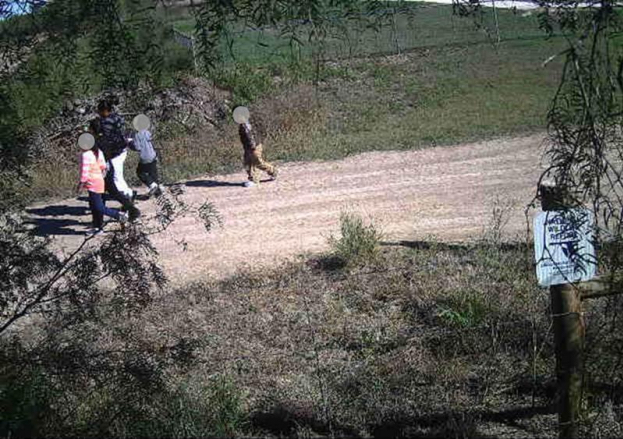
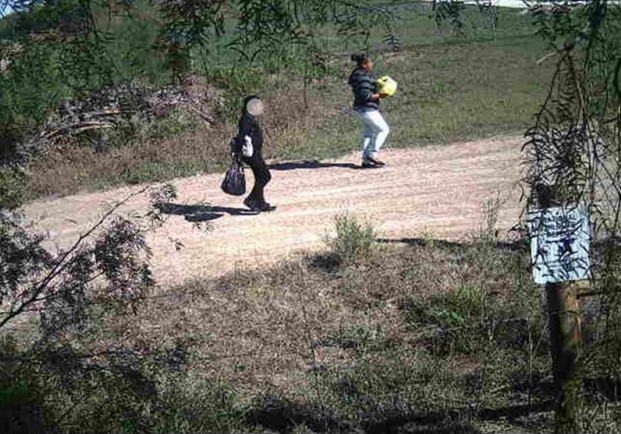
Why, then, did the Border Patrol push a false story about Sandra Rodriguez being down by the river? Was this misleading claim a canary in the coal mine for later incidents in other parts of the country?
In Washington state in February, a young man legally in the US under the DACA program, was apprehended during an operation originally intended to detain his undocumented father. Amid national expressions of concern, Immigration and Customs Enforcement (ICE) justified the son’s arrest by telling the media he was an admitted gang member. It later emerged that ICE had removed words from a statement made by the young man, which substantially changed its meaning. In the undoctored statement, he had denied gang membership.
In El Paso, also in February, ICE agents entered a courthouse where a woman was scheduled for a hearing to gain protection from domestic violence. The agents restrained the woman inside the courthouse—then claimed they’d confronted her outside, on the street. That claim was later roundly discredited by witness statements and videotape.
The November 2016 La Joya incident raises the question of whether such practices date back earlier, to after Donald Trump was elected but before he took office. The incident also suggests that in isolated communities in media and immigration-attorney “deserts”, immigrants may now be at special risk of being rounded up—even as immigration enforcers invent some facts and hide others, with little or no oversight from the public.
At a meeting with local immigration-rights activists a month after the incident, Padilla implied that Sandra Rodriguez’s arrest was unfortunate but added that the “route” where she was seen “is used to smuggle people and drugs,” and “some people use community events to take advantage.” He added that incidents like the one in La Joya occur very rarely. And he tried to reassure the audience. “Fear of going to a park or community center shouldn’t exist,” he said.
But fear does exist. And in La Joya it has wreaked havoc on community baseball. Ninety-seven percent of La Joya’s residents are Latinos, virtually all of Mexican descent, in a county where an estimated one in ten people are undocumented. According to one local baseball player with whom the ACLU of Texas has spoken, players since the incident have come to fear that they, their families, and their friends will be nabbed in the park and deported. Four months have passed since Rodriguez and her son were taken from the bleachers. Since then, community fear has only intensified following the inauguration of Donald Trump and his executive orders on immigration. Nowadays in La Joya, baseball games are often canceled because many team members fail to show up.
The fear has only increased for Sandra Rodriguez as well.
She and her family have lived in South Texas for six years. They migrated without papers from Mexico, her husband said, to escape narco-trafficking-related violence that some cousins were involved in. They worried that unless they left Mexico, they and their children they might be murdered.
After being taken out of the ballpark, Sandra and her son were kept for 27 hours at a detention center. While there she signed some papers. But being illiterate, she has no idea what was in them. After sleeping on a cold floor with plastic blankets and no pillows, she and Jiovanni were released late the next day. They were given no paperwork or notice to appear before an immigration judge. Sandra said the only thing they left with were some ominous words from an agent: “We’ll let your child finish school in May.”
She has no lawyer and no papers. All she’s got is a memory of a morning at a sports park in small-town South Texas that started bright and then turned dark. That, and tremendous fear.
